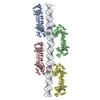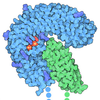+ Open data
Open data
- Basic information
Basic information
| Entry | Database: PDB / ID: 7wv4 | |||||||||
|---|---|---|---|---|---|---|---|---|---|---|
| Title | ectoTLR3-poly(I:C) cluster | |||||||||
 Components Components |
| |||||||||
 Keywords Keywords | IMMUNE SYSTEM/RNA / Toll-like receptor / dsRNA / Innate immunity / Receptor / IMMUNE SYSTEM / IMMUNE SYSTEM-RNA complex | |||||||||
| Function / homology |  Function and homology information Function and homology informationTLR3 deficiency - HSE / response to dsRNA / UNC93B1 deficiency - HSE / type III interferon production / positive regulation of type III interferon production / TICAM1 deficiency - HSE / TRAF3 deficiency - HSE / regulation of dendritic cell cytokine production / Toll Like Receptor 3 (TLR3) Cascade / inflammatory response to wounding ...TLR3 deficiency - HSE / response to dsRNA / UNC93B1 deficiency - HSE / type III interferon production / positive regulation of type III interferon production / TICAM1 deficiency - HSE / TRAF3 deficiency - HSE / regulation of dendritic cell cytokine production / Toll Like Receptor 3 (TLR3) Cascade / inflammatory response to wounding / TLR3-mediated TICAM1-dependent programmed cell death / activation of NF-kappaB-inducing kinase activity / toll-like receptor 3 signaling pathway / detection of virus / necroptotic signaling pathway / RIP-mediated NFkB activation via ZBP1 / endolysosome membrane / positive regulation of cytokine production involved in inflammatory response / Trafficking and processing of endosomal TLR / hyperosmotic response / positive regulation of macrophage cytokine production / toll-like receptor signaling pathway / pattern recognition receptor activity / cellular response to exogenous dsRNA / RSV-host interactions / response to exogenous dsRNA / negative regulation of osteoclast differentiation / ubiquitin-like protein ligase binding / positive regulation of interferon-alpha production / Regulation of TBK1, IKKε-mediated activation of IRF3, IRF7 upon TLR3 ligation / TICAM1,TRAF6-dependent induction of TAK1 complex / TICAM1-dependent activation of IRF3/IRF7 / cellular response to interferon-beta / positive regulation of chemokine production / extrinsic apoptotic signaling pathway / JNK cascade / TICAM1, RIP1-mediated IKK complex recruitment / positive regulation of interleukin-12 production / extracellular matrix / positive regulation of interferon-beta production / positive regulation of interleukin-8 production / positive regulation of JNK cascade / microglial cell activation / cellular response to mechanical stimulus / cellular response to virus / cellular response to type II interferon / positive regulation of interleukin-6 production / male gonad development / cellular response to xenobiotic stimulus / positive regulation of type II interferon production / positive regulation of inflammatory response / positive regulation of angiogenesis / positive regulation of tumor necrosis factor production / transmembrane signaling receptor activity / signaling receptor activity / double-stranded RNA binding / defense response to virus / early endosome / endosome membrane / positive regulation of canonical NF-kappaB signal transduction / defense response to bacterium / positive regulation of apoptotic process / Golgi membrane / lysosomal membrane / innate immune response / endoplasmic reticulum membrane / positive regulation of gene expression / signal transduction / positive regulation of transcription by RNA polymerase II / extracellular space / identical protein binding / membrane / plasma membrane / cytoplasm Similarity search - Function | |||||||||
| Biological species |  Homo sapiens (human) Homo sapiens (human)synthetic construct (others) | |||||||||
| Method | ELECTRON MICROSCOPY / single particle reconstruction / cryo EM / Resolution: 3.35 Å | |||||||||
 Authors Authors | Lim, C.S. / Jang, Y.H. / Lee, G.Y. / Han, G.M. / Lee, J.O. | |||||||||
| Funding support |  Korea, Republic Of, 2items Korea, Republic Of, 2items
| |||||||||
 Citation Citation |  Journal: Nat Commun / Year: 2022 Journal: Nat Commun / Year: 2022Title: TLR3 forms a highly organized cluster when bound to a poly(I:C) RNA ligand. Authors: Chan Seok Lim / Yoon Ha Jang / Ga Young Lee / Gu Min Han / Hye Jin Jeong / Ji Won Kim / Jie-Oh Lee /  Abstract: Toll-like Receptor 3 (TLR3) initiates a potent anti-viral immune response by binding to double-stranded RNA ligands. Previous crystallographic studies showed that TLR3 forms a homodimer when bound to ...Toll-like Receptor 3 (TLR3) initiates a potent anti-viral immune response by binding to double-stranded RNA ligands. Previous crystallographic studies showed that TLR3 forms a homodimer when bound to a 46-base pair RNA ligand. However, this short RNA fails to initiate a robust immune response. To obtain structural insights into the length dependency of TLR3 ligands, we determine the cryo-electron microscopy structure of full-length TLR3 in a complex with a synthetic RNA ligand with an average length of ~400 base pairs. In the structure, the dimeric TLR3 units are clustered along the double-stranded RNA helix in a highly organized and cooperative fashion with a uniform inter-dimer spacing of 103 angstroms. The intracellular and transmembrane domains are dispensable for the clustering because their deletion does not interfere with the cluster formation. Our structural observation suggests that ligand-induced clustering of TLR3 dimers triggers the ordered assembly of intracellular signaling adaptors and initiates a robust innate immune response. | |||||||||
| History |
|
- Structure visualization
Structure visualization
| Structure viewer | Molecule:  Molmil Molmil Jmol/JSmol Jmol/JSmol |
|---|
- Downloads & links
Downloads & links
- Download
Download
| PDBx/mmCIF format |  7wv4.cif.gz 7wv4.cif.gz | 532.2 KB | Display |  PDBx/mmCIF format PDBx/mmCIF format |
|---|---|---|---|---|
| PDB format |  pdb7wv4.ent.gz pdb7wv4.ent.gz | 431.3 KB | Display |  PDB format PDB format |
| PDBx/mmJSON format |  7wv4.json.gz 7wv4.json.gz | Tree view |  PDBx/mmJSON format PDBx/mmJSON format | |
| Others |  Other downloads Other downloads |
-Validation report
| Summary document |  7wv4_validation.pdf.gz 7wv4_validation.pdf.gz | 927.7 KB | Display |  wwPDB validaton report wwPDB validaton report |
|---|---|---|---|---|
| Full document |  7wv4_full_validation.pdf.gz 7wv4_full_validation.pdf.gz | 955.8 KB | Display | |
| Data in XML |  7wv4_validation.xml.gz 7wv4_validation.xml.gz | 74.7 KB | Display | |
| Data in CIF |  7wv4_validation.cif.gz 7wv4_validation.cif.gz | 114.6 KB | Display | |
| Arichive directory |  https://data.pdbj.org/pub/pdb/validation_reports/wv/7wv4 https://data.pdbj.org/pub/pdb/validation_reports/wv/7wv4 ftp://data.pdbj.org/pub/pdb/validation_reports/wv/7wv4 ftp://data.pdbj.org/pub/pdb/validation_reports/wv/7wv4 | HTTPS FTP |
-Related structure data
| Related structure data |  32845MC  7wv3C  7wv5C  7wveC  7wvfC  7wvjC C: citing same article ( M: map data used to model this data |
|---|---|
| Similar structure data | Similarity search - Function & homology  F&H Search F&H Search |
- Links
Links
- Assembly
Assembly
| Deposited unit | 
|
|---|---|
| 1 |
|
- Components
Components
| #1: Protein | Mass: 78423.375 Da / Num. of mol.: 4 / Fragment: ectodomain Source method: isolated from a genetically manipulated source Source: (gene. exp.)  Homo sapiens (human) / Gene: TLR3 / Cell line (production host): High Five / Production host: Homo sapiens (human) / Gene: TLR3 / Cell line (production host): High Five / Production host:  Trichoplusia ni (cabbage looper) / References: UniProt: O15455 Trichoplusia ni (cabbage looper) / References: UniProt: O15455#2: RNA chain | | Mass: 24369.598 Da / Num. of mol.: 1 / Source method: obtained synthetically / Source: (synth.) synthetic construct (others) #3: RNA chain | | Mass: 26370.277 Da / Num. of mol.: 1 / Source method: obtained synthetically / Source: (synth.) synthetic construct (others) Has protein modification | Y | |
|---|
-Experimental details
-Experiment
| Experiment | Method: ELECTRON MICROSCOPY |
|---|---|
| EM experiment | Aggregation state: PARTICLE / 3D reconstruction method: single particle reconstruction |
- Sample preparation
Sample preparation
| Component |
| ||||||||||||||||||||||||
|---|---|---|---|---|---|---|---|---|---|---|---|---|---|---|---|---|---|---|---|---|---|---|---|---|---|
| Molecular weight | Experimental value: NO | ||||||||||||||||||||||||
| Source (natural) | Organism:  Human (human) Human (human) | ||||||||||||||||||||||||
| Source (recombinant) | Organism:  Trichoplusia ni (cabbage looper) Trichoplusia ni (cabbage looper) | ||||||||||||||||||||||||
| Buffer solution | pH: 5.5 | ||||||||||||||||||||||||
| Buffer component |
| ||||||||||||||||||||||||
| Specimen | Conc.: 1.7 mg/ml / Embedding applied: NO / Shadowing applied: NO / Staining applied: NO / Vitrification applied: YES | ||||||||||||||||||||||||
| Specimen support | Grid material: COPPER / Grid mesh size: 300 divisions/in. / Grid type: Quantifoil R1.2/1.3 | ||||||||||||||||||||||||
| Vitrification | Instrument: FEI VITROBOT MARK IV / Cryogen name: ETHANE / Humidity: 100 % / Chamber temperature: 277 K |
- Electron microscopy imaging
Electron microscopy imaging
| Experimental equipment |  Model: Talos Arctica / Image courtesy: FEI Company |
|---|---|
| Microscopy | Model: FEI TALOS ARCTICA |
| Electron gun | Electron source:  FIELD EMISSION GUN / Accelerating voltage: 200 kV / Illumination mode: FLOOD BEAM FIELD EMISSION GUN / Accelerating voltage: 200 kV / Illumination mode: FLOOD BEAM |
| Electron lens | Mode: BRIGHT FIELD / Nominal defocus max: 2500 nm / Nominal defocus min: 1300 nm |
| Image recording | Electron dose: 50 e/Å2 / Film or detector model: GATAN K3 BIOQUANTUM (6k x 4k) |
- Processing
Processing
| EM software |
| |||||||||||||||||||||
|---|---|---|---|---|---|---|---|---|---|---|---|---|---|---|---|---|---|---|---|---|---|---|
| CTF correction | Type: PHASE FLIPPING AND AMPLITUDE CORRECTION | |||||||||||||||||||||
| 3D reconstruction | Resolution: 3.35 Å / Resolution method: FSC 0.143 CUT-OFF / Num. of particles: 59774 / Symmetry type: POINT | |||||||||||||||||||||
| Atomic model building | Protocol: RIGID BODY FIT | |||||||||||||||||||||
| Atomic model building |
|
 Movie
Movie Controller
Controller










 PDBj
PDBj





































